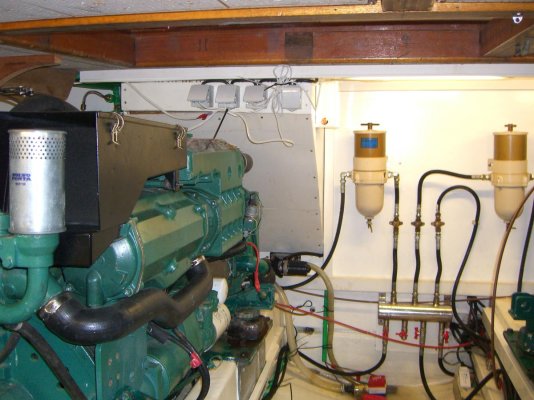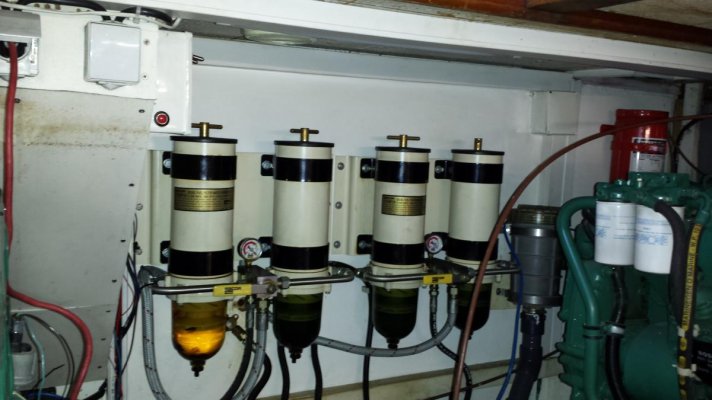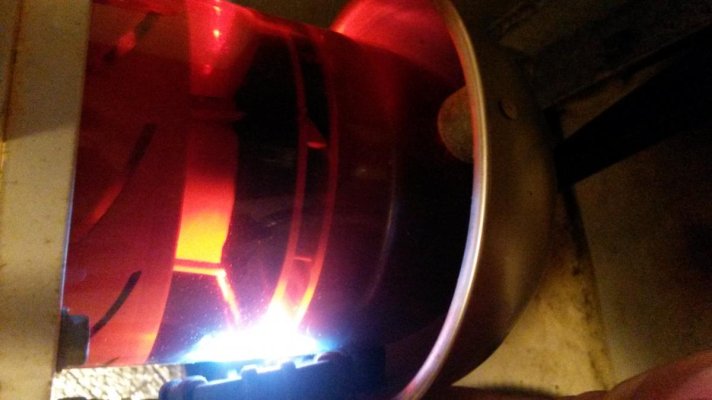I have a situation where to my eye, a filter needs to be changed but the majority of people at my marina say it wouldn't make sense. Rather than a 1000 words... does that black material at the bottom constitute a reason to pull the filter? If not, can you please give some detail as to why... thank you.
You are using an out of date browser. It may not display this or other websites correctly.
You should upgrade or use an alternative browser.
You should upgrade or use an alternative browser.
Reading the filter glass
- Thread starter Gilhooley
- Start date
The friendliest place on the web for anyone who enjoys boating.
If you have answers, please help by responding to the unanswered posts.
If you have answers, please help by responding to the unanswered posts.
ranger58sb
Guru
I can't see it well enough to tell, but the filter is drainable... so periodically opening the "spigot" (nut) at the bottom and letting any water build-up (and your gunk) drain would be normal, routine maintenance.
The internal element itself does need to be changed at (longer) periodic intervals. If you don't know when the element was last changed, it wouldn't hurt to do that, establish your own maintenance baseline...
Check the Racor site for additional guidance.
-Chris
The internal element itself does need to be changed at (longer) periodic intervals. If you don't know when the element was last changed, it wouldn't hurt to do that, establish your own maintenance baseline...
Check the Racor site for additional guidance.
-Chris
Capt.Bill11
Guru
First, get rid of that stupid metal fire shield so you can see in the clear bowl properly. 
After you get rid of the shield you can buy and install the nice plastic petcock drain RACOR makes for those filters.
Then drain the filter while shaking the bowl so the crap clinging to the sides and bottom of it will fall out. Then pull the element out and see what it looks like. If it looks dirty or dark in color change it.
After you get rid of the shield you can buy and install the nice plastic petcock drain RACOR makes for those filters.
Then drain the filter while shaking the bowl so the crap clinging to the sides and bottom of it will fall out. Then pull the element out and see what it looks like. If it looks dirty or dark in color change it.
RT Firefly
Enigma
Greetings,
Mr. 111. It will be impossible to shake the bowl if the filter housing is hard mounted. Mr. G. That black material is contamination of the fuel which sticks to the outside of the filter element when the engine is running (drawing fuel) and it falls to the bottom of the filter when the engine is stopped (not drawing fuel). It would not concern me too much unless a layer (in the 1cm. to 1.5 cm. range) starts to build up in the bottom of the filter but as Mr. 111 points out, that metal fire shield makes it very difficult to determine how much of a build up there is. The filter bowl need not be scrupulously clean. Do you have a filter/fuel vacuum gauge anywhere in the system?
Mr. 111. It will be impossible to shake the bowl if the filter housing is hard mounted. Mr. G. That black material is contamination of the fuel which sticks to the outside of the filter element when the engine is running (drawing fuel) and it falls to the bottom of the filter when the engine is stopped (not drawing fuel). It would not concern me too much unless a layer (in the 1cm. to 1.5 cm. range) starts to build up in the bottom of the filter but as Mr. 111 points out, that metal fire shield makes it very difficult to determine how much of a build up there is. The filter bowl need not be scrupulously clean. Do you have a filter/fuel vacuum gauge anywhere in the system?
Rogerh
Guru
- Joined
- Aug 27, 2013
- Messages
- 724
- Location
- USA
- Vessel Name
- At Last
- Vessel Make
- 1990 Jefferson 52 Marquessa
About a year ago I had the same crud and decided to clean the entire filter. If you go to Compass Marine web site he has a good description with photos that makes it easy to do. Just get the kit, remove the filter assembly and follow the directions on Compass site. They are very good. I did it because I wanted it clean and known starting point after purchasing the boat. It took me about 2 hours per filter. Good luck!
RT Firefly
Enigma
Greetings,
Along the lines of cleaning Racor filter bowls. Rather than disassemble my units, I used a long cable tie moved up and down vertically to agitate the hardened black crud at the bottom of the bowls. The cable tie was stiff enough to slide past the cyclone unit and flexible enough to conform to the curvature of the bottom. I drained the "solution" (diesel and crud) through the petcock at the bottom several times while recharging with a bit fresh diesel until bowl appeared clean. New filter, filled her up with fresh diesel and as they say VIOLA!
Along the lines of cleaning Racor filter bowls. Rather than disassemble my units, I used a long cable tie moved up and down vertically to agitate the hardened black crud at the bottom of the bowls. The cable tie was stiff enough to slide past the cyclone unit and flexible enough to conform to the curvature of the bottom. I drained the "solution" (diesel and crud) through the petcock at the bottom several times while recharging with a bit fresh diesel until bowl appeared clean. New filter, filled her up with fresh diesel and as they say VIOLA!
SaltyDog
Senior Member
- Joined
- Nov 11, 2007
- Messages
- 251
Ahh the scrub it clean approach Mr. RT. I like. But......
May I add an upgraded idea.
Using a vacuum extractor (if you don't have one or two, you work too hard) use the small rigid hose on one to both to extract the crud and scrape the bowl clean at the same time.
The metal shield is required by some (mine for sure) insurance companies. I had the normal service ones before switching to the marine versions, but the vacuum extractor method was and still is my way. YMMV.
The handiest upgrade on my boat is still the outboard motor gas tank squeeze bulb I installed right before the Racor filters. Open Racor, insert vacuum tube, use it to scrub if needed, pump extractor a few strokes, empty Racor, remove element, replace element, replace O'rings, pump squeeze bulb until housing is full, replace lid. Done. Not a drop spilled. Less than 5 minutes by a long shot.
To the original question the need to replace a Racor is best determined by the following:
1. vacuum gauge readings.
2. Is it easier to replace it than to figure out if it needs replacing?
If one doesn't know the answer to #2 then it is my best advice that you replace it just for the experience. It is one of the things one should know how to do blind-folded and totally drunk. One may just find that changing fuel filters in the worst of conditions might be the single most valuable skill aboard a boat. Swimming might be an exception.
May I add an upgraded idea.
Using a vacuum extractor (if you don't have one or two, you work too hard) use the small rigid hose on one to both to extract the crud and scrape the bowl clean at the same time.
The metal shield is required by some (mine for sure) insurance companies. I had the normal service ones before switching to the marine versions, but the vacuum extractor method was and still is my way. YMMV.
The handiest upgrade on my boat is still the outboard motor gas tank squeeze bulb I installed right before the Racor filters. Open Racor, insert vacuum tube, use it to scrub if needed, pump extractor a few strokes, empty Racor, remove element, replace element, replace O'rings, pump squeeze bulb until housing is full, replace lid. Done. Not a drop spilled. Less than 5 minutes by a long shot.
To the original question the need to replace a Racor is best determined by the following:
1. vacuum gauge readings.
2. Is it easier to replace it than to figure out if it needs replacing?
If one doesn't know the answer to #2 then it is my best advice that you replace it just for the experience. It is one of the things one should know how to do blind-folded and totally drunk. One may just find that changing fuel filters in the worst of conditions might be the single most valuable skill aboard a boat. Swimming might be an exception.
Capt.Bill11
Guru
Greetings,
Mr. 111. It will be impossible to shake the bowl if the filter housing is hard mounted.
No it's not. I do it all the time if need be.
You just take the side of your fist or palm of your hand and bang on the filter housing at the top or bottom repeatedly as you drain the filter. The filter body is just mounted with two bolts near the middle so you can shake it pretty good by doing that. It breaks more stuff loose by far than just draining the bowl. In fact some times you have to hit the body pretty good just to get the junk broken up enough on the bottom to get the fuel to drain out at all.
Steve
Guru
I haven't seen mention of it for a few years now but there used to be a lot of talk on boating forums about the Racor elements having a "water blocking" treatment that would wear out after about a year in diesel, working or not. So in a dual filter system like I have and putting few hours per year lately I would have to change (and do) both filters even though one would maybe not have actually filtered a drop of diesel. Anything to this?
Drake
Guru
- Joined
- Sep 16, 2014
- Messages
- 611
- Location
- Independent Republic of Texas
- Vessel Name
- Small World
- Vessel Make
- Defever 50
First, get rid of that stupid metal fire shield so you can see in the clear bowl properly.
After you get rid of the shield you can buy and install the nice plastic petcock drain RACOR makes for those filters.
Then drain the filter while shaking the bowl so the crap clinging to the sides and bottom of it will fall out. Then pull the element out and see what it looks like. If it looks dirty or dark in color change it.
Great advice. I would only add if in doubt, change it. Much better than hearing "cough, cough, quiet" in the middle of navigating a tricky lock.
I had that experience at altitude in an airplane. It will cure you forever!
aussiemade
Newbie
- Joined
- Aug 5, 2011
- Messages
- 4
- Location
- Mexico
- Vessel Name
- Aussie Made
- Vessel Make
- Grand Banks Classic
The shield is a CG requirement and also your insurance company. The metal valve/tap on the bottom of the filter is also a requirement. The plastic valves are for trucks and not CG nor insurance approved. A good surveyor will tell you that too. Cheers!
psneeld
Guru
I believe they are required for commercial vessels....not pleasure unless your insurance company requires them.The shield is a CG requirement and also your insurance company. The metal valve/tap on the bottom of the filter is also a requirement. The plastic valves are for trucks and not CG nor insurance approved. A good surveyor will tell you that too. Cheers!
ABYC suggests them but neither of my last vessels failed survey without them.
http://www.westmarine.com/WestAdvisor/ABYC-Requirements-for-Diesel-Fuel-Filters
Last edited:
Drake
Guru
- Joined
- Sep 16, 2014
- Messages
- 611
- Location
- Independent Republic of Texas
- Vessel Name
- Small World
- Vessel Make
- Defever 50
The shield is a CG requirement and also your insurance company. The metal valve/tap on the bottom of the filter is also a requirement. The plastic valves are for trucks and not CG nor insurance approved. A good surveyor will tell you that too. Cheers!
Actually, my surveyor is where I got the idea to remove mine. It was his suggestion.
aussiemade
Newbie
- Joined
- Aug 5, 2011
- Messages
- 4
- Location
- Mexico
- Vessel Name
- Aussie Made
- Vessel Make
- Grand Banks Classic
Sounds like some surveyors I wouldn't want. Steve d Antonio did a nice piece on this in one of the Passagemaker publications. Cheers!
Capt.Bill11
Guru
Sounds like some surveyors I wouldn't want. Steve d Antonio did a nice piece on this in one of the Passagemaker publications. Cheers!
Did he also recommend the magic magnetic fuel "filters", as he has before, in that same article as well?

r-rossow
Senior Member
- Joined
- Jul 30, 2008
- Messages
- 105
- Location
- Norway
- Vessel Name
- Southern Promise MMSI 258170360
- Vessel Make
- Ocean Alexander 55 Mk1
Racor has an aftermarket vacuum gauge that will fit into the T handle on top of the filter. The gauge will stick at its highest position so you not have to be in the ER to constantly monitor the vacuum. The gauge will tell you if the filter element is filling up or not.
In my experience in SAR and towing operations, we see way way more boaters get into trouble by clogged fuel filters than by ER fires. Having a see-thru bowl and vacuum gauge will help you checking on filter condition.
Before bringing Southern Promise from southern Portugal to Scandinavia, I had the original single Volvo/Racor all metal filter units replaced with dual Racor 1000 units with see-thru glasses and built-in vacuum gauge. No way was I to have engines stop of fuel starvation and be forced to change filter elements crossing the Bay of Biscay from northern Spain up into the English Channel. For you not that familiar with European waters; The Bay of Biscay is a notorious storm hole and is the receiving end of Richard on Dauntless storm Ivan when going from the Azores to Ireland.


In my experience in SAR and towing operations, we see way way more boaters get into trouble by clogged fuel filters than by ER fires. Having a see-thru bowl and vacuum gauge will help you checking on filter condition.
Before bringing Southern Promise from southern Portugal to Scandinavia, I had the original single Volvo/Racor all metal filter units replaced with dual Racor 1000 units with see-thru glasses and built-in vacuum gauge. No way was I to have engines stop of fuel starvation and be forced to change filter elements crossing the Bay of Biscay from northern Spain up into the English Channel. For you not that familiar with European waters; The Bay of Biscay is a notorious storm hole and is the receiving end of Richard on Dauntless storm Ivan when going from the Azores to Ireland.


Similar threads
- Replies
- 14
- Views
- 1K
- Replies
- 1
- Views
- 1K

